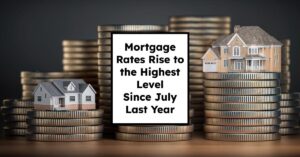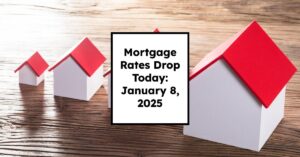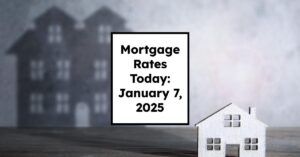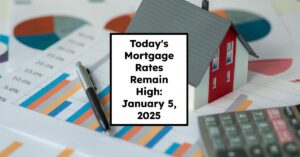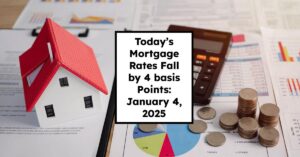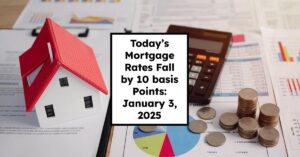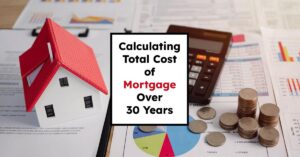Mortgage rates are rising, and for many, this comes as a concern. As of early January 2025, we have seen mortgage rates hit an impressive 6.99%, marking the highest level since July 2024. This increase is significant because it directly affects homebuyers and current homeowners looking to refinance. With ongoing rate increases, many are left wondering how this will affect their ability to purchase homes or refinance existing mortgages.
Mortgage Rates Rise to the Highest Level Since July Last Year
Key Takeaways
- Current Rate: The average contract interest rate for 30-year fixed-rate mortgages has risen to 6.99%.
- Demand Drop: Total mortgage application volume fell by 3.7% from the previous week, as higher rates continue to push buyers away.
- Refinance Activity: There was a 2% increase in refinance applications from the previous week, yet they remain 6% lower than last year.
- Home Purchase Applications: Applications to purchase a home dropped by 7% for the week, significantly lower than this time last year.
Understanding the Mortgage Rate Surge
The rise in mortgage rates is not just a number. It signifies changing economic conditions and influences borrowing power. The Mortgage Bankers Association (MBA) reported that the surge in mortgage rates has led to a significant drop in demand for new loans. With the average contract interest rate currently at 6.99% for conforming loans, the motivation for many prospective home buyers is diminishing.
The rates for 30-year fixed-rate mortgages have continuously increased, moving from 6.97% to 6.99% in just a week. This translates to a direct impact on monthly payments, which can be a game-changer for families planning to buy their first home or invest in real estate.
| Mortgage Type | Current Rate (%) | Change from Last Week (%) | Points (Including Origination Fee) |
|---|---|---|---|
| 30-Year Fixed Conforming | 6.99 | +0.02 | 0.68 |
| Refinance Applications | – | +2 | – |
| Home Purchase Applications | – | -7 | – |
Source: Mortgage Bankers Association
The Impact on Mortgage Applications
Weak mortgage demand is evident in the statistics shared recently. The MBA's seasonally adjusted index shows a 3.7% decrease in overall mortgage application volume compared to the previous week. Even though refinancing applications increased by 2%, this figure pales compared to last year’s numbers, where refinancing was considerably stronger.
- Refinance Applications: They see a rise mainly due to fluctuating rates, but lower levels compared to previous years indicate the lack of aggressive demand due to rising rates.
- Home Purchase Applications: The 7% decline serves as a clear indicator that buyers are becoming more cautious and are potentially holding off purchasing new homes until the rates stabilize or decrease.
What Influences Mortgage Rates?
Several factors contribute to the rising mortgage rates. Economic data plays a crucial role in this context:
- Job Market Reports: Employment data significantly influences the overall economic landscape and hence dictates mortgage rates.
- Inflation Indicators: Rising inflation often leads to increased interest rates as lenders seek higher returns to balance the economic environment.
Recent comments from Matthew Graham, Chief Operating Officer at Mortgage News Daily, highlighted how reports on inflation and job openings react to market sentiments and can cause immediate spikes in mortgage yield rates.
Homebuyers and Sellers in Today's Market
The current mortgage rate climate creates unique challenges for both buyers and sellers. For buyers, high rates lead to increased monthly costs, making homes less affordable. Conversely, sellers face a moving market; while higher rates mean fewer buyers, those that do enter the market are potentially more serious.
According to Joel Kan, MBA’s Vice President, we are witnessing the slowest pace of purchase applications since February 2024. This lack of interest can be attributed to several factors:
- Higher House Prices: Even with an increase in home supply compared to last January, homes remain pricey.
- Market Sentiments: Buyer sentiment is shifting downwards as they reassess their budget and efforts are invested elsewhere.
Looking Ahead: Future Rate Predictions
Experts predict that rates may continue their upward trajectory in the short term, influenced by upcoming economic reports and the Federal Reserve's interest rate decisions. Observing the trends can provide insights into potential homebuying strategies moving forward.
According to a report by Fannie Mae, expectations have changed significantly, with estimates suggesting that rates might not dip below 6% soon. Instead, a more gradual risk of increases appears likely.
| Date | Predicted Rate (%) | Comments |
|---|---|---|
| January 2024 | 6.91 | Steady rise noted since July 2024 |
| February 2024 | 7.00 | Anticipated monthly job trends will influence |
| March 2024 | >7.00 | Home prices and supply will keep rates high |
Source: Fannie Mae
Recommended Read:
Mortgage Rate Predictions January 2025: Forecast for Homebuyers
Mortgage Rates Outlook for 2025: Will They Drop?
Based on the search results, mortgage rates in 2025 are expected to remain elevated compared to pre-2022 levels, but there is a general consensus among experts that they will gradually decline throughout the year. Here’s a summary of the key predictions and factors influencing mortgage rates in 2025:
1. General Consensus: Gradual Decline
- Most forecasts predict that the average 30-year fixed mortgage rate will range between 6% and 6.5% by the end of 2025, down from current levels around 6.7%-7% .
- For example, Fannie Mae expects rates to average 6.4% in 2025, ending the year at 6.3%, while Realtor.com predicts an average of 6.3% and a year-end rate of 6.2% .
- The Mortgage Bankers Association (MBA) forecasts a more conservative range, with rates hovering between 6.4% and 6.6% throughout the year .
2. Factors Influencing Mortgage Rates
- Federal Reserve Policy: The Fed’s cautious approach to rate cuts, driven by inflation concerns and economic data, will play a significant role. While the Fed has already cut rates in 2024, further cuts in 2025 are expected to be gradual and data-dependent .
- Inflation and Labor Market: If inflation remains sticky or re-accelerates, mortgage rates could stay elevated. Conversely, a cooling labor market and subdued inflation could push rates lower .
- Economic Policies: The incoming Trump administration’s policies, such as tariffs and tax cuts, could impact inflation and government debt, potentially keeping rates higher than expected .
- Geopolitical Events: Global uncertainties, such as conflicts or supply chain disruptions, could also influence mortgage rates, either pushing them higher or lower depending on the economic impact .
3. Will Rates Fall Below 6%?
- Most experts believe it is unlikely that mortgage rates will fall below 6% in 2025. For instance, Mark Fleming of First American predicts rates will range between 6% and 6.5%, while Lawrence Yun of the National Association of Realtors (NAR) suggests 6% will be the new normal .
- However, some forecasts, like those from Fannie Mae and the NAR, suggest rates could dip slightly below 6% by the end of 2025, but this is not the majority view .
4. Impact on Homebuyers and Refinancing
- Lower rates in 2025 could improve affordability slightly, but home prices are expected to remain high, limiting the overall impact on buyers .
- Refinancing activity may increase if rates drop into the mid-5% range, but this is unlikely to benefit homeowners who secured ultra-low rates during the pandemic .
Final Thoughts on Mortgage Rates
In this environment, navigating the housing market requires careful consideration. Prospective homebuyers or those thinking of refinancing should keep an eye on the Federal Reserve's meeting minutes and other economic indicators set to release soon. These factors will ultimately influence how rates develop throughout 2025.
The looming employment report will be crucial—a significant deviation from expectations could drive rates either higher or potentially stabilize them, allowing a clearer path for buyers and sellers alike.
With mortgage rates rising to a high point this week, understanding the math behind the changes is vital for stakeholders in real estate. The economic landscape coalesces to create an environment where consumers need to stay informed. This detailed look at current mortgage trends illustrates that fluctuations can lead to a mix of opportunities and challenges—a dance individual buyers and sellers must navigate adeptly to realize their real estate goals.
Work with Norada in 2025, Your Trusted Source for
Real Estate Investing
With mortgage rates fluctuating, investing in turnkey real estate
can help you secure consistent returns.
Expand your portfolio confidently, even in a shifting interest rate environment.
Speak with our expert investment counselors (No Obligation):
(800) 611-3060
Recommended Read:
- NAR Predicts 6% Mortgage Rates in 2025 Will Boost Housing Market
- Mortgage Rates Predictions for 2025: Expert Forecast
- Half of Recent Home Buyers Got Mortgage Rates Below 5%
- Mortgage Rates Need to Drop by 2% Before Buying Spree Begins
- Will Mortgage Rates Ever Be 3% Again: Future Outlook
- Mortgage Rates Predictions for Next 2 Years
- Mortgage Rate Predictions for Next 5 Years
- Mortgage Rate Predictions for 2025: Expert Forecast
- Prediction: Interest Rates Falling Below 6% Will Explode the Housing Market
- Mortgage Rate Predictions: Why 2% and 3% Rates are Out of Reach
- How Lower Mortgage Rates Can Save You Thousands?
- How to Get a Low Mortgage Interest Rate?
- Will Mortgage Rates Ever Be 4% Again?
